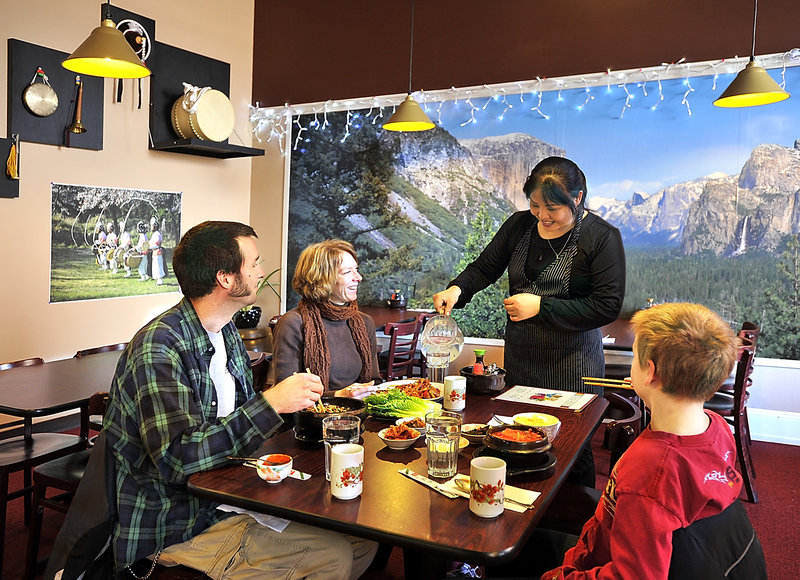Korea House, a restaurant revised from its first iteration as Happy Teriyaki into something truer to the chef/owners’ Korean roots, is a source of fiery stews; rich, satisfying soups; and braised, deeply flavored fish that will stir your soul and fill you with courage.
At least the food there seemed to revitalize me and my companion just that much one cold night.
You can play it safe with a nice bowl of noodles, such as the Ramyun ($6.95), thin noodles in a spicy broth with vegetables and egg.
You can enjoy the classics we’ve started to become familiar with, such as bi bim bop ($13.95) — beef, egg and vegetables served on steamed rice with “spicy-sweet sauce” — or bul go gi ($15.95), stir-fried, thin-sliced beef with “savory-sweet sauce.”
Or you can try new things from the intriguing menu.
Starting with the scallion pancake called Korean vegetable pancake on the menu ($8.95) is highly recommended. A thin wheat-flour batter holds the pungent green leaves of scallions in a chewy, crisp-on-the-edges pancake that are utterly delicious dipped in a saucer with soy sauce in it.
Korean seafood pancake ($15.95) is made entirely with beaten eggs, seafood and a few scallion leaves. Octopus tentacles, shrimp and fish stuff the Asian omelet with variety and flavor, making it a generous meal in itself.
Edamame ($3.95) — soy beans cooked in their pods and salted — were bright green and irresistible as we split open the pods and ate them up.
Hot sake ($8) and a few beers and wines by the glass are on the drinks list.
Douk guk ($11.95) tops the soup list, and our server, co-owner Myung You, was enthusiastic when he heard my companion order it. “Everyone in Korea eats douk guk on the morning of the first day of the year,” he told us. “It wakes you up.”
Made with the fresh beef bones that the kitchen uses to make rich, gelatinous beef stock every day (according to the server), the soup is full of thinly sliced rice cakes that are smooth in texture and mild, some sheets of nori or dried seaweed, cooked egg sliced into ribbons and skinny strips of beef.
We ordered it with dumplings too, so that it was more like a thick stew than a soup. It came from the kitchen bubbling in its own black stoneware bowl set on a heat-proof tray.
“When do they open?” my friend wanted to know about the restaurant. “I want to eat this for breakfast every day.”
Korean radish is an ingredient that pops up in many of the dishes. A wide, oval or round root vegetable with white flesh and skin except for a green “shoulder,” Korean radish makes a fresh-tasting, cool vegetable in the stews that feature chili-laced sauce and fish. It is also sometimes used to make kimchee, the pickled vegetables always served as “banchan” or sides with a Korean meal.
For banchan on the night of our meal, we enjoyed slippery, chewy seaweed with red chili sauce, fish cakes that were seafood-flavored sticks made with rice flour and tossed in a sharp and savory sauce, and sauted bok choy that was hot as fire, its chili paste enough to bring tears. Best of all was the kimchee made with big pieces of Napa cabbage that fizzed in our mouths. Its chili paste was hot but not overwhelming, and its sour flavor was vibrant and wonderful.
Kimchee, it turns out, ferments with strains of bacteria that differ from the bacteria in sauerkraut because of the cooler temperature they are allowed to ripen in. Originally fermented in pots or jars partially buried in the ground, the condiment always has been intended to add pizzazz to bland rice and grain dishes. The Korea House’s kimchee is lively and fresh, the best I’ve tasted.
Ggong chi jo rim ($13.95) presented braised chunks of mackerel, bone-in and not omitting the head, with Korean radish in spicy sauce. The spicy sauce was deep red, and turned the sweet, dark-fleshed mackerel into something cooler and mild, while the watery texture of the radish refreshed the mouth with every bite. The dish is served on lettuce leaves, another cool component among the warm and hot ingredients.
According to Myung You, who is also a chef (and the dishwasher, he said with a laugh), his wife, Kum You, co-owner and main chef, comes from a very large Korean family. The restaurant is named after the house she grew up in.
Hundreds of sauce jars, large earthenware containers filled with fermenting kimchee, pickled peppers, miso and many other things were prepared every year to supply the feasts that her father, head of the large extended family, would give during the year.
Her grandmother is 104, Myung You said, and still working “a little bit.”
Two clementines and a sliced apple comprised our excellent dessert at this friendly, unpretentious and wonderful restaurant that’s worthy of a visit any time of the year.
N.L. English is a Portland freelance writer and the author of “Chow Maine: The Best Restaurants, Cafes, Lobster Shacks and Markets on the Coast.” Visit English’s website, www.chowmaineguide.com.
Send questions/comments to the editors.



Success. Please wait for the page to reload. If the page does not reload within 5 seconds, please refresh the page.
Enter your email and password to access comments.
Hi, to comment on stories you must . This profile is in addition to your subscription and website login.
Already have a commenting profile? .
Invalid username/password.
Please check your email to confirm and complete your registration.
Only subscribers are eligible to post comments. Please subscribe or login first for digital access. Here’s why.
Use the form below to reset your password. When you've submitted your account email, we will send an email with a reset code.